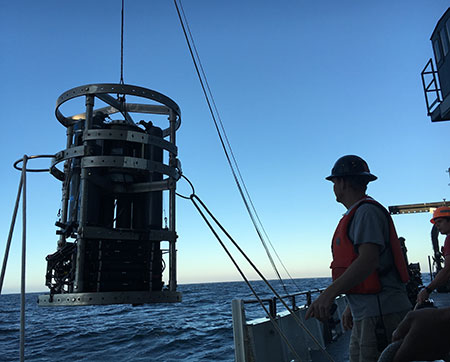It’s not a great thing when the CTD (Conductivity, Temperature and Depth) Rosette bumps into the hull of the ship, as it did on one of the launches today.
The CTD weighs about half a ton when the water sample canisters are empty, and about 1,300 pounds when the bottles are full. A wayward swing could not only damage the sensitive – and expensive – equipment, it could cause serious injury and death.
But the CTD has an outer cage meant to protect the equipment, and it did its job very well. No harm, no foul.
Each launch and recovery operation requires – at minimum – a crew member to operate the winch, a person to tend the various cables attached to the CTD, two people to handle the tag lines and a marine or research technician (also called “martech”) to coordinate the operation. All roles except for the winch operator and martech are usually performed by a member of the research team.
There are multiple casts in a day, so it’s a good opportunity to train those who are new to the process. What happened today was that the tag lines were kept too tight, keeping the CTD in too close to the ship. As the ship rocked, it bumped into the CTD.
The incident was part of a typical day in ocean research, full of successes and failures. There were sensors that worked as they should have, and several that did not. A vacuum pump stopped working, but it was successfully repaired.
“This is what education is about,” said chief scientist Jim Bishop. “How do people learn stuff? If you can’t commune with the instrument, then what’s the point of being out here at all?”
Indeed. The student tag-line operators got back in the game with the next few casts, which went off without a hitch. (Well, not literally … )
Be sure to return to this site once the voyage ends (and more bandwidth is available) for more photos — and videos — from the research effort.


